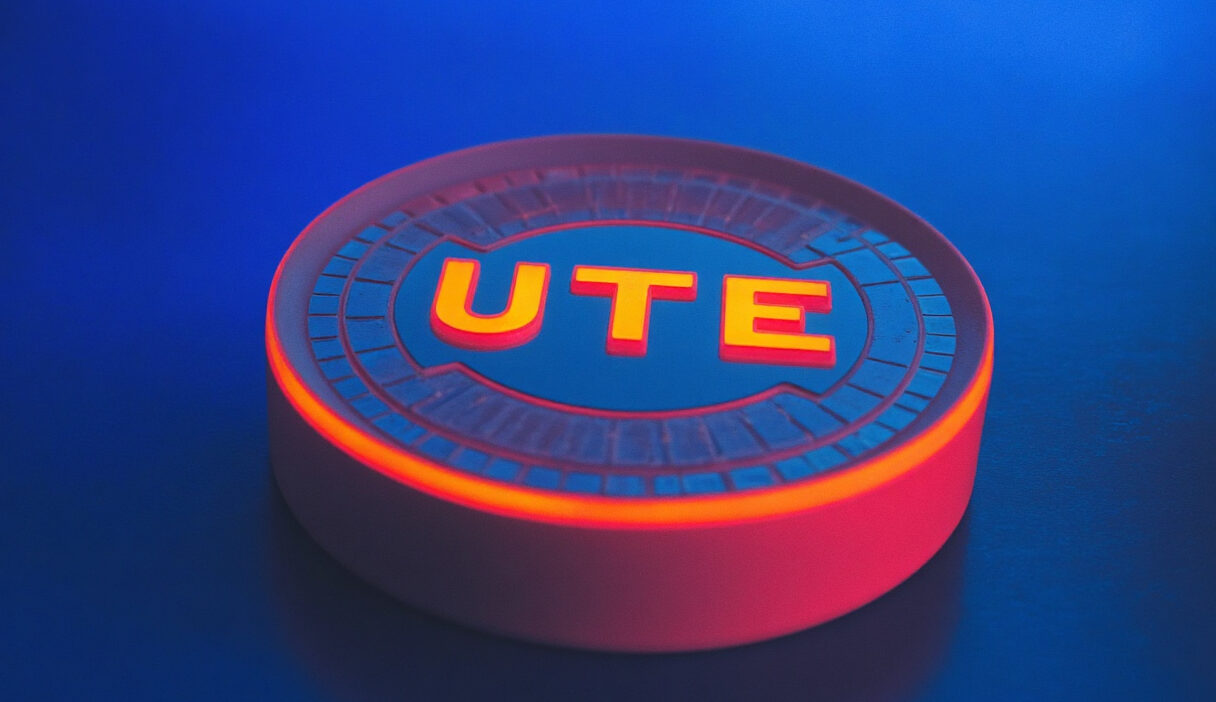Introduction
Universal Truth Engine ($UTE) burst onto the scene as another Solana-based memecoin just a few hours old – yet it’s already the second hottest topic in town. With a name ripped straight out of sci-fi lore (and perhaps an Elon Musk tweet), $UTE managed to hit a market cap of roughly $373K within ~4–5 hours of launchdexscreener.com. In fact, at one point it briefly exceeded $1 million market cap during an early buying maniarugcheck.xyz, before a dramatic pullback. The token’s Whisper Score of 3/5 indicates moderate buzz and some skepticism from the start. Still, $UTE enjoyed heavy trading momentum, fueled by hype on X.com, the allure of an AI-themed narrative, and quick-trigger whale activity. In this deep scan, we’ll dissect $UTE’s wild price action, the social media chatter (and how Elon Musk’s xAI speculation might have played a role), whale movements and holder patterns, as well as examine if there’s any actual “truth” or utility behind the flashy name. We maintain a critical but fair lens, giving you the real story behind the hype in Mugen: City’s underbelly.
Quick Stats (Universal Truth Engine $UTE):
- Market Cap (FDV): ~$339K (as of ~4.5h post-launch)dexscreener.com; initial spike reportedly pushed it above $1M before correctionrugcheck.xyz.
- Age: ~4–5 hours since launch (pair created ~4h 30m ago)dexscreener.com.
- Volume: ~$10.4M traded in first 4 hoursdexscreener.com – extraordinarily high turnover, even eclipsing $ART’s volume.
- Transactions: 68,800 swaps recorded, with buy vs sell volume roughly equal ($5.2M each)dexscreener.com. Nearly 10k unique buyers and 8.7k sellers so fardexscreener.com, indicating huge participation.
- Holders: ~2,200 addresses within hours (with top 10 holders ~18% of supply)x.com – fairly spread out ownership early on.
- Whisper Score: 3/5 (decent buzz but notable caution in the whispers).
- Social Momentum: ~2 posts every 5 minutes on X about $UTE; 606 new views on trackers in the past hour (very high interest).
- Platform: Launched on PumpSwap via Pump.fun. Liquidity ~$75K, but only ~59% of LP tokens lockedrugcheck.xyz (higher rug risk than $ART).
- Narrative: Riding on a trending AI theme – name references a “Truth Engine”, possibly linked to recent xAI discussions (more below), but no real product behind it yet.
Trading Momentum and Price Rollercoaster
Figure: $UTE’s market cap over its first 4 hours – a sharp spike to ~$1M, then a steep drop and partial recovery. If $ART’s chart was a hockey stick, $UTE’s chart is more of a lightning bolt. Universal Truth Engine saw an even more explosive initial pump than Artcoin did, but also a more violent correction. Within the first 30–40 minutes of trading, $UTE rocketed from near-zero to around $1.0M in market cap (an increase of roughly +1500% or more from its starting price). DexScreener data captured a +467% gain at the 4-hour markdexscreener.com – which is huge, but it belies the fact that $UTE had already round-tripped considerably from a higher peak. In raw price terms, the token jumped from ~$0.00006 at launch to about ~$0.0010+ at the apex, then fell back to ~$0.0003 range. This “peak and valley” is evident in the volume: an eye-watering $10.4 million traded in just a few hoursdexscreener.com, far surpassing typical micro-cap volumes. Traders were churning $UTE at a frenzied pace, clocking nearly 69k transactions by the 4-hour markdexscreener.com – a sign of extremely high turnover.
To break down the timeline: in the first minutes, aggressive buying (likely by bots and fast movers) sent the price vertical. By around 1 hour in, momentum was red-hot, and $UTE was among the top gainers across Solana (DexScreener’s trending showed $UTE as #2 new pair, up 465% at ~4h indexscreener.com, only behind another meme coin). However, shortly after that initial climax, reality hit hard. A wave of selling crashed the price down. The token that soared to a FDV in seven figures came tumbling down to mid-six figures. Reports from RugCheck show $UTE’s market cap was around $1.1M at one point with ~2,980 holdersrugcheck.xyz, and then much lower shortly after – implying a lot of holders got in near the top and contributed to the sell-off.
Several factors likely drove this steep dump: early buyers taking massive profits, sniper bots exiting (more on that later), and notably, the liquidity pool’s vulnerability. Only ~58.7% of $UTE’s LP was locked by the creatorrugcheck.xyz, meaning about 41% of the pool could potentially be yanked. It’s unconfirmed if the dev actually pulled liquidity, but even the possibility can spook investors. The partial liquidity lock is much lower than $ART’s, so risk of a rug or sudden liquidity removal was higher. The chart’s sheer drop suggests either a coordinated dump or significant liquidity outflow happened around 1.5–2 hours in (the point where our figure shows the plunge).
After the bottom (~$270K MC, roughly $0.00027 price), $UTE saw a modest bounce-back. In the last hour (between hour 3 and 4), the price actually recovered ~25%dexscreener.com from its lows, indicating dip buyers stepped in. Perhaps bargain hunters figured that even after the crash, $UTE was still up several hundred percent from launch and could stabilize or have a second run. By ~4.5 hours post-launch, the market cap sat around $339Kdexscreener.com, which is where it seems to have settled for now – still up ~5-6x from the start (so early birds are still in profit), but far below the heights achieved initially. The liquidity pool shows about $37K in UTE and $37K in SOLdexscreener.com, so roughly ~$74K liquidity, which is slightly lower than $ART’s pool. This could be due to some LP being removed or simply the lower price now.
In summary, $UTE’s trading journey in its first hours was a wild ride of boom and bust. The momentum was incredibly strong out of the gate (even stronger than $ART’s in percentage terms), but it could not be sustained. The token effectively went through a mini pump-and-dump cycle all within an afternoon. High risk, high reward indeed – some traders who got in very early and cashed out near the top hit the jackpot, while those who FOMO-bought the spike got burned on the way down. The partial recovery shows there’s still life in $UTE, but whether it can reclaim old highs or will flatline is the question ahead. For now, it’s a case study in just how quickly a memecoin can swing from euphoria to panic, especially in the unbridled environment of Pump.fun.
Hype on X.com and the Elon Musk Factor
Universal Truth Engine’s launch timing and branding suggest it was deliberately crafted to ride a wave of social media hype. Uniquely, $UTE’s name aligns with a topic that was trending in tech circles: the concept of a “truth engine” in AI. Mere hours before $UTE’s creation, prominent figures on X were discussing whether Elon Musk’s new AI venture (xAI) should build a “Universal Truth Engine”twitter.com. In fact, a tweet by crypto influencer Mario Nawfal posed that exact question – clearly the $UTE creator noticed this buzz. By naming the token “Universal Truth Engine,” they tapped into a hot meme: AI, truth-seeking, Elon Musk – all potent narrative fuel in 2025’s zeitgeist.
The result was almost immediate hype on X.com. As soon as $UTE launched (literally at the 0-minute mark), call accounts and crypto commentators started broadcasting it. One “New Project Alert” post from an analyst called Dape Agent announced $UTE 3 minutes after launch, with a cautionary “⚠️ Risk” label alongside the contract addresstwitter.com. That tells us two things: (1) $UTE was on the radar of influencers instantly, and (2) even from the start, they warned this is a risky play (likely because of how fast these pumps move and perhaps the unverified nature of the project). Another account, Bitcong Crypto Gems, shared the contract at launch as wellx.com, indicating multiple channels were actively pushing awareness of $UTE.
The social momentum ramped up as $UTE’s price skyrocketed in the first hour. On Crypto Twitter, posts about how $UTE was “the next 100x AI meme” or jokes referencing Musk and “truth GPT” started circulating. Some speculators implied that maybe Elon or xAI would notice this token – a stretch, but hype doesn’t need rationality. The Whisper Score of 3/5 suggests that while there was significant talk about $UTE, it wasn’t overwhelmingly positive. Indeed, many posts carried a mix of excitement and caution. The name attracted interest (who wouldn’t be curious about something called Universal Truth Engine?), but savvy traders also remembered how these scenarios often end. For instance, the memewizd account commented in essence: “600k now… doesn’t seem all that special, but the key is that Elon Musk really resonates with this idea”, poking at the tenuous Elon connection that people were using as justificationx.com. In other words, even proponents acknowledged that $UTE’s main appeal was the story or meme around it, not any substance.
During the peak, social media sentiment was euphoric. People were tweeting things like “UTE to the moon 🚀” and sharing snapshots of their quick profits. The token trended in some crypto circles simply due to the sheer volume of mentions and the impressive initial gains. However, once the rug (or perceived rug) happened and the price tanked, the tone shifted. X posts in the aftermath included wariness – users asking “what happened with $UTE?!” and others replying with memes of something blowing up then crashing. The “I told you so” crowd emerged, reminding everyone that a 2-hour-old token with no real project was bound to be a gamble.
Interestingly, one undercurrent in the hype was the AI narrative: a few tweets theorized this could be “the token for truth seekers in AI” or drawing parallel to “TruthGPT” (a term Elon had used before). While most serious folks didn’t buy that narrative, it added a flavor to $UTE’s hype that pure memes like $ART didn’t have. It’s an example of how just a whiff of association with trending tech (AI, Elon’s ventures) can amplify a token’s profile – even if that association is purely coincidental or opportunistic.
In summary, the social media hype for $UTE was strong but short-lived. It had a special ingredient – the timely AI theme – that gave it an initial edge. X.com was alight with both promotion and precaution around $UTE. That push helped inflate the bubble quickly. However, as soon as cracks showed (price dumping), the hype began cooling just as fast. By 3-4 hours in, the cadence of posts slowed, and the crowd’s attention started shifting elsewhere (there are always new coins on Pump.fun popping up). $UTE’s story on social media is a testament to how crucial a narrative is for these meme coins, but also how fragile hype can be when not backed by anything concrete.
Whale Activity, Holder Distribution, and On-Chain Signals
From an on-chain perspective, Universal Truth Engine had all the hallmarks of a whale playground. In the earliest blocks of its existence, sniper bots and fast-moving whales likely swarmed to buy $UTE at the cheapest prices. The token’s extreme liftoff hints that automated snipers were very active – they often account for the initial candle shooting up. As Pine Analytics reported for Pump.fun launches, devs or insiders sometimes fund sniper wallets to jump-start trading and create FOMOainvest.comainvest.com. It’s quite possible $UTE saw such manipulation: the rapid pump could have been accentuated by these insiders buying and then unloading quickly. These sniper wallets typically sell within minutesainvest.com, which aligns with $UTE’s early peak and then fast decline.
Looking at holder distribution, early data indicated the top 10 holders owned about 18% of $UTE’s supplyx.com. This was when the market cap was ~$261K (shortly after launch). 18% in top 10 is slightly more decentralized than $ART’s 20% in top 10 at a similar stagetwitter.com, but it’s still a notable concentration. It implies there were at least a handful of sizable holders (whales) who accumulated significant positions quickly. Perhaps these were the same call group leaders or insider wallets that aped in at launch. With nearly 2,300 holders in totalrugcheck.xyz after the first big wave, having 18% in ten wallets is not too bad – it means the supply wasn’t hyper-centralized (no single wallet held, say, 10% alone; rather, maybe each of top 10 averaged 1.8%). However, when those big holders act in unison or one after the other to sell, the impact is pronounced.
One specific on-chain red flag: the creator’s behavior. RugCheck shows the Creator’s balance is “SOLD” for $UTErugcheck.xyz, just like $ART. This suggests the token creator dumped their allocation very early. Often, a Pump.fun token creator might pre-mint some tokens for themselves or simply buy a bunch at launch with a separate wallet. The “creator sold” means they did cash out whatever tokens they had control of. Combined with the low LP lock (only ~58% locked), this is troubling – the dev not only potentially didn’t lock all liquidity, but also sold their tokens. It’s almost textbook rug-pull behavior, though in this case the project didn’t go to zero and liquidity wasn’t completely pulled (so not a full rug, more of a partial rug or just an aggressive profit-taking by dev). The dev likely made a killing during that spike to $1M, leaving subsequent buyers holding the bag.
The whale activity during the dump is also worth noting. As $UTE plunged, on-chain watchers saw some wallets cashing out large chunks. It wouldn’t be surprising if some of those top 10 holders mentioned earlier exited entirely during the drop – maybe the same whales who helped pump it decided to bail when they sensed momentum flipping. The volume data shows roughly equal buy/sell volumes (~$5.2M each) in the first hoursdexscreener.com, which on the surface suggests equilibrium, but in reality likely means a transfer of bags: strong hands selling to weaker (or later) hands. The fact that unique sellers (8,755) are slightly fewer than unique buyers (9,782)dexscreener.com indicates some buyers haven’t sold yet. These could be new holders who bought in on the way down or at the bottom expecting a bounce. Thus, there are still whales or at least medium-sized holders sitting on a lot of $UTE waiting for a better exit if possible.
Another on-chain signal: the LP lock percentage difference compared to $ART. $UTE’s ~58.7% LP lockedrugcheck.xyz means over 40% of liquidity pool tokens were likely in the hands of the creator or initial liquidity providers unlocked. This is significant because it means they could remove a big chunk of liquidity (which would both net them whatever SOL is in that portion and crash the price for everyone else). We do not have confirmation if liquidity was pulled, but given the magnitude of price drop, it’s plausible either some liquidity got yanked or just sold into heavily. In any event, prospective traders seeing that stat would be (rightly) cautious. It’s possible that some whales who noticed the low LP lock also decided to get out early, fearing a rug.
In conclusion, whales had a field day with $UTE. Early insiders likely profited enormously, and the creator themselves didn’t stick around. The holder distribution became more spread out after the initial frenzy, but by then the damage was done from coordinated sell-offs. If $UTE is to have a second life, it would rely on those who picked up tokens post-dump and any new speculators coming in – the original whales have mostly left the building, it seems. For any trader eyeing $UTE now, the on-chain evidence urges caution: this token’s early phase was dominated by short-term whale games, and any future moves could see similar sudden shifts if remaining big holders decide to exit.
What (If Anything) Is the “Universal Truth Engine”? (Fundamentals)
As intriguing as the name “Universal Truth Engine” sounds, let’s be clear: there is no actual product or technology by this name associated with the token. This is a meme coin that co-opted a phrase from Twitter discourse. There is no whitepaper describing a truth-verification engine, no AI algorithm in development, no team of researchers working on solving truth in AI. In other words, $UTE’s fundamentals are effectively non-existent, much like Artcoin’s.
The entire “utility” of $UTE, if we can call it that, lies in its meme value. The token doesn’t have a website or a published roadmap. The Pump.fun listing for $UTE is minimal, only showing the stats and the trading threadpump.fun. There is no evidence of a community DAO or any use-case beyond trading. It’s a classic case of misleading branding – take a hot buzzword and slap it on a token. To someone not in the know, “Universal Truth Engine” might sound like a serious AI project, but that illusion fades quickly upon seeing that it’s trading on a meme token platform and was launched by an anonymous user.
One could argue that the concept behind the name has resonance – perhaps envisioning a decentralized oracle or truth verification network. But $UTE is not that (at least not today). There’s a slim chance an enterprising community member might try to retrofit a purpose to it, e.g., “Let’s actually build a fact-checking dApp and use $UTE as a token.” However, given the creator already cashed out, it’s unlikely there’s any development effort coming from the origin. The community, if it persists, would have to take initiative to create any value beyond pure market speculation.
No known partnerships or endorsements exist for $UTE. It’s not linked to any real AI projects, despite the tongue-in-cheek speculation on Twitter. Elon Musk certainly isn’t endorsing this coin; the only link to him is that he had mused about the need for truth-centric AI, and opportunists named a token after the idea. It’s a free-for-all out there – and $UTE is a prime example of a meme coin hitching itself to a cultural moment (in this case, AI hype).
The Whisper Score of 3/5 could be partially reflecting that fundamentals are lacking – the community chatter likely notes “yeah cool name, but nothing behind it.” People whisper that the emperor has no clothes, so to speak, even as others are dancing around the emperor hoping for gold. This score being lower than $ART’s suggests more doubt about $UTE’s authenticity or longevity from the get-go.
In summary, Universal Truth Engine as a project is truthfully just an engine for speculation right now. There is no universal truth being dispensed – only the hard truth that this is a meme play. Anyone buying $UTE should treat it as such. Without a pivot to real development (which would be surprising), $UTE’s value proposition is entirely, “Can we get enough people to buy this token because the name sounds cool and the chart looks hype?” That might work for a short burst (as it did), but long-term it’s a shaky foundation. If one is searching for actual crypto projects with AI and truth solving, look elsewhere – $UTE isn’t it. This token is a creature of the current memecoin microcosm, not of the AI revolution it name-drops.
Community and Sentiment Post-Pump
Despite the rocky price action, $UTE did manage to build a fast-following during its brief glory. Within hours, over 2,200 holders had joined the ranksdexscreener.com. On Pump.fun, its thread had around 59 replies not long after launchpump.fun – not as high as $ART’s, but still showing engagement. The slightly lower thread activity compared to Artcoin might be due to the quicker flame-out; people had less to celebrate in chat once the price tanked. However, at its peak, $UTE’s community sentiment was exuberant. Early participants were bragging about insane ROI in minutes, and many were calling others to hop on the “truth engine” before it left the station.
After the crash, the tone in the community shifted notably. The Telegram groups and Pump.fun thread turned towards troubleshooting: “Do we know who rugged? Was liquidity pulled?” and pep talks like “If the dev’s out, this is fully community now, maybe we can revive it.” Some holders have tried to rally around the concept of making $UTE a community-driven token since the dev is presumably gone. This is a common post-rug coping mechanism – sometimes it works (rarely, a community can keep a dead token alive as a meme), but often it fizzles out as interest wanes.
The current sentiment can be described as cautiously hopeful among those still holding, and indifferent to negative among those who sold or avoided it. Many traders moved on immediately once they took profits or cut losses – the memecoin crowd’s attention span is short. Those who stayed are either true believers in trying to spark a second wind or simply bagholders with little choice. On X, sentiment analysis would show a lot of excitement mentions in the first 2 hours, then a spike in negative/contextual mentions around the dump, and now a trickle of optimistic “maybe it can bounce” posts. The Whisper Score 3/5 suggests an average level of chatter; not entirely dead (people are still talking about it) but also not strongly positive.
It’s worth noting, some community members are attempting to spin a narrative that “the Universal Truth Engine is now a community experiment – can the community find utility or meme it back up without devs?” This sort of narrative appeals to the decentralization ethos (no dev, truly community-owned because the creator left). If it gains traction, it could improve sentiment. However, it requires a committed group to take charge, which may or may not materialize given many were just in it for a quick trade.
Comparing to $ART, $UTE’s community feels more shaken due to the magnitude of the early dump. The trust was dented. While $ART holders saw a more gradual dip and might still feel bullish, $UTE holders experienced a gut punch which typically makes communities more defensive or prone to in-fighting (“you told me to buy, now we’re down!”). That said, in the wild world of meme tokens, memories are short. If $UTE stabilizes and perhaps some influencer suddenly tweets about it again, the community could reignite like nothing happened.
In conclusion, the $UTE community is at a crossroads – it can either disperse as just another failed pump, or it can attempt to regroup and reinvent the token’s story. The current sentiment is mixed, leaning bearish in the immediate aftermath of the dump but not entirely devoid of hope. The next day or two will be crucial: if some positive catalyst or second wave of hype hits, sentiment could recover; if not, it will likely fade as remaining holders slowly give up. For now, they hang in the balance, with cautious optimism trying to paper over a quite justifiable wariness.
Conclusion and Outlook
Universal Truth Engine ($UTE) is a prime example of 2025’s hype-driven microcap phenomena, where narrative and timing are everything, and actual substance is optional. In this deep scan, we peeled back the layers of $UTE’s meteoric rise and dramatic fall within its first few hours. The findings paint a picture of a coin that was engineered for a quick splash: a trending-topic name to lure speculators, a fair launch on a platform known for meme mania, and an aggressive initial pump likely aided by insiders and bots. It’s the recipe for a crypto firecracker – bright and explosive, but burning out fast.
From a critical standpoint, $UTE appears to have been more of a quick profit vehicle than a long-term project. The early evidence of dev sell-off and low liquidity lockrugcheck.xyz is hard to ignore; these moves speak louder than any hopeful tweets. They indicate that those in control never intended to stick around. And indeed, the market reacted accordingly, with the token’s value coming back to earth once that realization set in.
However, being fair in our assessment, it’s also true that some traders made money on $UTE – potentially a lot of money. For those nimble enough to enter and exit early, $UTE offered huge percentage gains in a very short time. The opportunity was there and seized by those who understand the game. In the subculture of Pump.fun and meme tokens, this is almost celebrated as a skill – riding the lightning and getting off in time. So in that sense, $UTE “succeeded” as a vehicle for speculation, even if it failed as a sustainable token project.
Looking forward, what is the outlook for Universal Truth Engine? As of now, it’s trying to find a floor and perhaps a second life. If the broader market for memes remains hot, $UTE might see another mini-pump, especially if some narrative catches on (for example, if Elon Musk or xAI coincidentally mention something about “truth engines” again, expect speculators to rush back in, however irrational that connection is). The community left holding the token may attempt grassroots efforts to add value or at least keep the meme alive. But without developer support or any inherent utility, $UTE faces an uphill battle to retain relevance.
The more likely scenario is that $UTE will follow the path of many Pump.fun tokens before it: a big initial splash, then a gradual fade in both price and attention. New shiny coins will steal the limelight, and $UTE will be remembered as yesterday’s play. Unless… the community truly does something novel. In the spirit of open possibilities, one could imagine they try to turn it into an “event token” for tracking truths or some social experiment. Crypto has seen stranger things, albeit rarely.
For traders still interested, $UTE remains a high-risk instrument. The volatility is still present (there may be sudden spikes or drops as liquidity is thinner now). One should only commit funds they can afford to lose in such a speculative bet. The Whisper Score 3/5 and the chatter around it implies a moderate chance of some revival, but nothing certain.
In closing, Universal Truth Engine was less about “truth” and more about the stark reality of meme coin gambling. The truth is that it’s mostly hype, whales, and quick flips – not unlike a casino game skinned with a tech theme. Our deep scan gives you the unvarnished story: big hype, big dump, little substance. If you choose to engage with $UTE or tokens like it, do so with the knowledge of what it really is. As the edgy investigators of Mugen: City would advise – trust data over slogans, and don’t get swept up by fancy names. In the end, the universal truth here might just be the timeless warning: caveat emptor in cryptoland.
What’s the real story behind Universal Truth Engine ($UTE)?
The content, What’s the real story behind Universal Truth Engine ($UTE)?, published on Mugen:City is for informational and entertainment purposes only.
We do not offer financial advice, investment recommendations, or trading strategies.
Cryptocurrencies, NFTs, and related assets are highly volatile and risky — always DYOR (do your own research) and consult with a professional advisor before making any financial decisions.
Mugen:City, its writers, and affiliates are not responsible for any losses, damages, or financial consequences resulting from your actions.
You are fully responsible for your own moves in the degen world. Stay sharp, stay rebellious.





